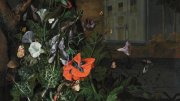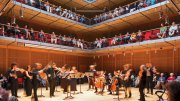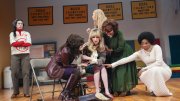There is music in DNA loops. The genome, which otherwise would be the height of a refrigerator, folds into a microscopic bundle inside the nucleus of a cell, knitting itself into “loops” of genetic information. Four years ago, composer and scientist Amir Bitran ’16, Ph.D. ’23, watched a three-dimensional video model of the process and “heard” it as music in his head: intersecting melodies, the tempo quickening and relenting as the loops grow and shrink, chaos resolving into clarity.
Bitran was a graduate student then, [August 18 addendum: Bitran's Ph.D. advisor was Gordon professor of chemistry Eugene Shakhnovich] and had previously completed a laboratory rotation with Leonid Mirny, professor of medical engineering and science (who’d created the 3D model video). A year later, Bitran’s piece “When DNA Makes Loops”—with Mirny as scientific consultant—premiered at Paris’s Salle Cortot concert hall, as a part of the Muse-IC Project, which commissions works inspired by new scientific research. It was the first time Bitran combined these long-held interests. He had always worried that science-inspired music would feel prosaic, didactic, and, frankly, a bit insufferable. “But I found that the natural world has so many beautiful things going on that should be widely known,” he says. “It’s both useful for me as a composer to draw inspiration from the scientific world, and also useful as a scientist to be able to distill ideas into their most beautiful and most clear essence.”
It took a while for him to see it, but science and music have always blended for Bitran. He was raised by musicians with an appreciation for science: his violinist father is a member of the Grammy-winning Latin American classical ensemble Cuarteto Latinoamericano, and his flutist mother studied music cognition, and now language cognition, as a cognitive psychologist at Northeastern University. Music was non-negotiable in their household. At age five, Bitran started piano lessons, but found himself far more interested in composing than practicing. He’d scrawl his best imitations of music notation on staff paper for his piano teacher to play at his next lesson. “Which meant playing totally random notes, because I had no idea what I’d notated,” he says. But he found happiness in creating something that had not been there before.
At about that time, he started asking his parents for books on the natural world. During a visit to the San Francisco Exploratorium on a family vacation, he saw an exhibit on how DNA provides the template for protein synthesis—a topic he would expand upon later in his Harvard dissertation on how proteins fold into their specific structures. Ten-year-old Bitran didn’t understand all the scientific intricacies, but he thought, “I really want to understand what’s going on here and how this all works.” The next day, he asked his parents for a book on genetics and read it obsessively for the rest of the trip.
His interest in science grew through middle school, as did his interest in music. He loved rock bands like Green Day (“Something about the teenage angst that I had going on at the time,” he jokes) and, later, Queen. “The scale of pieces like ‘Bohemian Rhapsody’ just blew me away,” he says. He was awed that rock music could be as grand and rousing as an orchestral piece.
Bitran didn’t begin composing seriously until high school, moving toward contemporary classical compositions that often incorporated the accented and syncopated rhythms of Latin American music he’d grown up listening to with his father. He headed to Harvard to study physics, but kept music as a serious second pursuit: singing in the University Choir and Harvard-Radcliffe Collegium Musicum. Meanwhile, Cambridge professional music ensembles played his pieces at the Harvard Composers Association’s annual performance of new works. None of his pieces then were inspired by science: “I saw music and science as occupying two very different parts of my brain, two parts that didn’t intersect.”
Now, science infuses all his compositions. The reason is simple: A lot of the things that fascinate scientists also fascinate music audiences. Take protein folding, for instance. The process is all about dynamics, proteins colliding with water molecules on an unseeable scale. “A lot of these ideas of motion, energy, and vibration, when you translate them into musical form, they actually create music that listeners like,” Bitran says. The scientific influence is subtle enough in his kinetic, stirring, surprising pieces that listeners feel the excitement of the science but are not forced to plod through every technical detail. “There’s something poetic, if you zoom in and ask yourself, what is it that you care about in the science?” Bitran says. “Then, you have to find a way to translate that into music.”
Most of his compositions begin with only Bitran and his phone, singing melodies as they occur to him and recording voice notes about possible instrument arrangements—working toward a “sonic backbone.” Then he turns to the piano. Sometimes, he uses technology to achieve the sounds in his head. His recent composition “Hidden Whispers” made audible a sound normally undetectable to human ears: elephant infrasonic communication, rumblings below 20 Hz they use to communicate with other elephants across the jungle. He used transposed infrasonic recordings from the Cornell Lab of Ornithology as the base of his piece: the strings supply one side of the conversation and the woodwinds the other. The dialogue morphs with each repetition, like a long-distance game of telephone across the jungle.
Now a postdoctoral research fellow at the University of California, Berkeley, Bitran spends his days in the lab probing his dissertation questions with new experimental techniques. At night, he works on a new piece for Baroque instruments inspired by the chemical reactions that produced life on earth, which will premiere in Paris in 2024. This composition will ask a similarly intriguing “why”: Since molecules can exist in two mirror image configurations, why is only one version found in nature? “How is it that, in the early Earth, that symmetry was broken?” Bitran asks. As always, he hears music in the science of the natural world.









